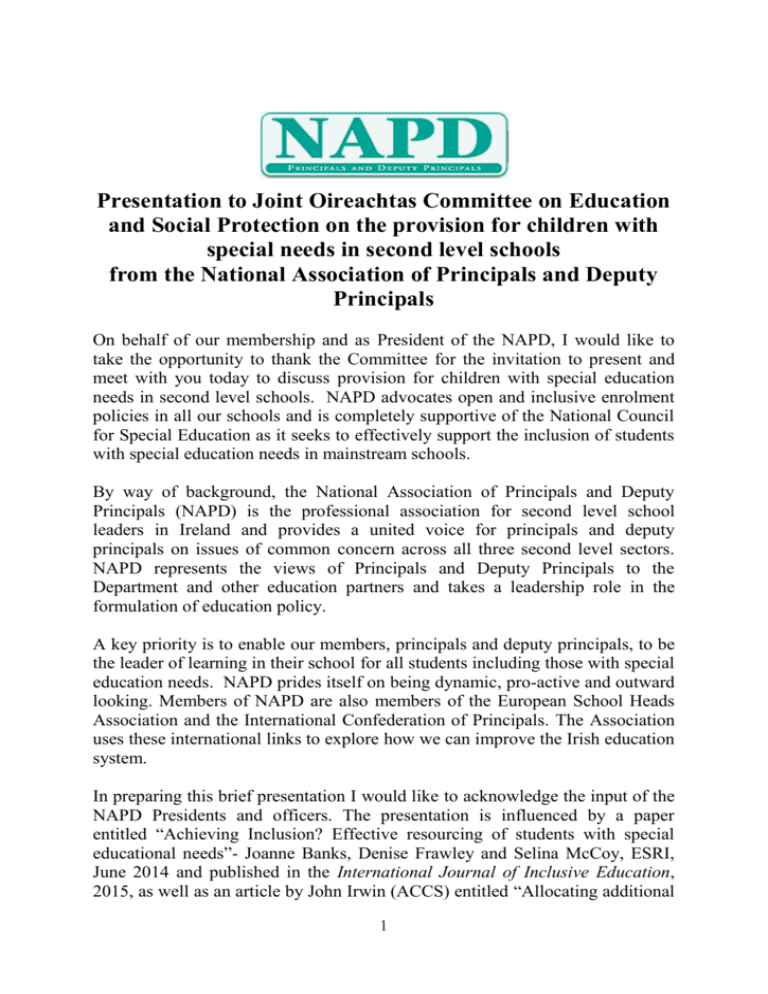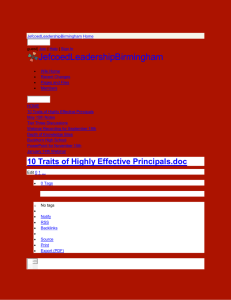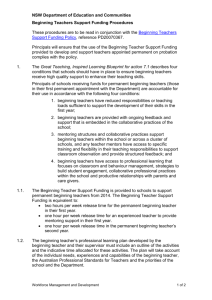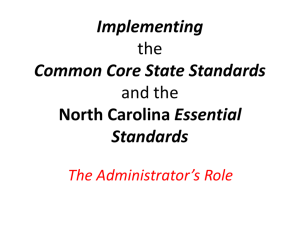Presentation from National Association of Principals and Deputy
advertisement

Presentation to Joint Oireachtas Committee on Education and Social Protection on the provision for children with special needs in second level schools from the National Association of Principals and Deputy Principals On behalf of our membership and as President of the NAPD, I would like to take the opportunity to thank the Committee for the invitation to present and meet with you today to discuss provision for children with special education needs in second level schools. NAPD advocates open and inclusive enrolment policies in all our schools and is completely supportive of the National Council for Special Education as it seeks to effectively support the inclusion of students with special education needs in mainstream schools. By way of background, the National Association of Principals and Deputy Principals (NAPD) is the professional association for second level school leaders in Ireland and provides a united voice for principals and deputy principals on issues of common concern across all three second level sectors. NAPD represents the views of Principals and Deputy Principals to the Department and other education partners and takes a leadership role in the formulation of education policy. A key priority is to enable our members, principals and deputy principals, to be the leader of learning in their school for all students including those with special education needs. NAPD prides itself on being dynamic, pro-active and outward looking. Members of NAPD are also members of the European School Heads Association and the International Confederation of Principals. The Association uses these international links to explore how we can improve the Irish education system. In preparing this brief presentation I would like to acknowledge the input of the NAPD Presidents and officers. The presentation is influenced by a paper entitled “Achieving Inclusion? Effective resourcing of students with special educational needs”- Joanne Banks, Denise Frawley and Selina McCoy, ESRI, June 2014 and published in the International Journal of Inclusive Education, 2015, as well as an article by John Irwin (ACCS) entitled “Allocating additional 1 teaching resources to schools to promote inclusion” to be published in the forthcoming edition of Education Matters. Inclusive education policies have resulted in a greater number of students with SEN attending mainstream schools with prevalence estimates as high as 25% of the school population with some form of additional need. Until recently a combination of funding models have been used which include through-put general allocation model (GAM) and input (individual) based funding for children depending on the severity of their need. Resources for “high incidence” SEN students are based on the allocation received the previous year whereas low incidence SEN students are allocated resources based on the nature and type of need. NAPD welcomes the NCSE Report issued in 2014 commonly known as the Stack Report which advocates that additional supports to schools be based on the educational profile of the school which comprises a baseline allocation, information on the number of students with complex needs, students’ standardised test scores, the gender balance in the school and data gathered from a social context survey completed by school principals. Colleague principals have reservations about their ability to provide accurate information about family backgrounds, medical cards, social housing and employment status. The suggestion that the social profile will now be based on the number of students who qualify for a waiver of fees for the Junior Certificate examinations is welcome. The result of a pilot study involving 20 secondary schools which is ongoing is eagerly awaited. It appears that socially disadvantaged schools are more likely to have high numbers of students with SEN, a wide range of abilities, a charged emotional environment as well as extreme learning needs among the lowest attaining students. The proposed changes envisaged in the NCSE 2014 report will result in increasing autonomy being assigned to principals where it is assumed that they will deliver national objectives of inclusion. A lack of consensus among principals and stakeholders on the meaning of inclusion may result in an implementation gap with discrepancies between policy intentions and school practices on the ground. Media commentary in recent years has highlighted individual cases of hardship, shortages of SNAs but year on year DES figures show there has been an increase in the number of SEN teachers sanctioned and investment by the state in SEN. The 2014 NCSE report lists the need to measure student outcomes based on the increased funding. Principals understand the need and requirement to be accountable for additional resources but there is no doubt that the level of autonomy envisaged in the NCSE 2014 Report will pose challenges for school 2 leaders who are already overburdened by a lack of administrative and leadership supports. It would be remiss of me as Director of the NAPD on the occasion of a presentation before the Joint Oireachtas Committee not to highlight some of the challenges being faced by my colleagues at the coalface on a day to day basis. The lack of a renewed middle management structure to facilitate the building of leadership capacity within our schools is a challenge. The additional work being undertaken by senior management teams as a result of middle management retirements. The need for a SENCo – trained and with the necessary time to administer SEN allocated resources and collate the necessary reports. The system knowledge loss created by the numbers of senior teachers who retired early during the recession. The break in the continuum of passing of accumulated knowledge from senior teachers to newly appointed teachers. The change to PTR and the challenge to replace retired teachers. The challenge of continuing to offer a broad range of subjects a Leaving Certificate level. The sheer volume of administration work cuts into time which could be better used in leading learning. The challenge of creating a relevant timetable with reduced staff numbers and increased pupil numbers. The challenge of financial management in a time of continual reduction of capital funding. The challenge of motivating disillusioned staff because of the lack of promotional prospects within the school. The challenge of maintaining a positive school climate as we seek to implement Junior Certificate reform - especially in dual union schools. The challenge of sourcing suitably qualified substitute teachers at times of peak demands. The need for supervision for Principals and Deputy Principals similar to that provided for guidance counsellors. The need for support and resources for Principals and Deputy Principals to facilitate the implementation of the Junior Certificate reform. The need for a Leader of Learning post to facilitate the implementation of the Junior Certificate reform. 3 The challenge of keeping our schools up to date in the area of Information Technology. The volume of work involved in preparing submissions in relation to applications for Summer Works Schemes and the sometime unrealistic time limits and deadlines attached to same. The additional challenge of dealing with issues which arise in the area of social media and the level of up-skilling required of Principals and Deputy Principals to be best placed to deal with such issues. The fact that duty social workers are only on duty until 17.00 hrs in all but a few areas of the country. The lack of availability of NEPS assessments available to schools. (Two to three a year for a school of 600 students) However, despite these concerns, principals and deputies continue to do their very best by and for their students and in the area of special needs the following points are offered to encourage debate. Inclusive education is now recognised as the most appropriate provision for learners with special educational needs. Our more diverse student population has impacted on the organisation and delivery of special education in post primary schools. Schools now support students with many complex learning, physical, social and emotional needs. The complexity of needs requires many layers of support within school setting e.g. resource teaching, learning support, individualised planning, reasonable accommodations for State Exams, SNA support and interventions from student support teams. At second level, the idea of the sticky label prevails, once a student is assigned resources they remain with them. The provision, diagnosis and assessment of additional needs of students are embedded in the medical model. This is counterproductive to the model of target setting, growth and improvement. The need to provide a label and seek a diagnosis had led to a model of engagement between schools and service providers e.g. CAMHS, HSE which is based too heavily on initial diagnosis and assessment. Little emphasis is placed on treatment, therapy, on-going support and re elevation. The school often finds itself left exclusively to support the educational, physical, social and emotional needs of students. Circular70/2014 gives guidance to schools on the deployment and organisation of teaching resources for students with SEN including the identification of students needing “high incidence and low incidence” support. The role of SEN coordinator needs to be ring fenced in the middle/senior management structures. There is much ambiguity as to role interpretation and it is compounded by 4 inconsistent levels of support to facilitate role enactment. Many SENCo roles are carried out in a voluntary capacity and receive little professional support. The role is complex and challenging and the success of a school’s SEN department is largely dependent on the competency and dedication of the SEN Coordinator. The volume of work and time required in order to maximise the educational outcomes for the students involved and also to maximise the teachers, deployment to best achieve these outcomes, is quite high. As the best system is one which changes regularly to best accommodate the needs of the students, a competent well co-ordinated approach to SEN provision is needed. Schools need to be funded to appoint an individual with the appropriate skill-set to manage and lead this work rather than have the principal decide how much time should be allocated to “conducting co-ordination activities” from the quantum of hours assigned to the school. The “Do IT Profiler” is being piloted in a number of different education settings by City of Dublin ETB. This web based tool has the capacity to screen learners to identify their specific educational needs and to provide guidance on the necessary supports as well as being able to track progress over time. A tool such as this can efficiently identify those with SEN and can help ensure that the student’s needs are specifically responded to rather than being given some form of generalised educational support. Transition to post primary for special needs students has improved especially with the introduction of the pupil passport. Parents are still concerned around provision for transfer, particularly around SNA support, as the child transitions from primary to post primary. Greater challenges occur again making the transition out of post primary school. The Disability Access Route to third level is not yet standardised across all third level institutions and there are particular challenges for students with intellectual disabilities. It is clear that opportunities for Further Education are often based on geographical location, transport options and the financial status of home. The existing model of support provision in post primary schools relies very heavily on extraction from mainstream classes in individual or small group settings. This has helped create a culture amongst mainstream teachers that it is the preserve of a specialised group of teachers to provide for the needs of SEN students. There must be greater emphasis on team teaching and on the delivery of whole staff support around differentiation. As a profession we need to focus the mindset of every teacher that we are all special needs teachers. This can only be achieved through initial teacher training and investment in continual professional development. The model of “High Incidence” provision from NCSE remained unchanged since 2009. Its purpose is to provide support for students with Specific 5 Learning Difficulties and Borderline/Mild General learning disabilities. The allocated hours in many schools only touches the surface of support required to allow these students achieve their full potential. It has created particular challenges for students in the Mild General Learning Disability category especially at senior cycle level. There is a lot of ambiguity around individualised planning for students with special educational needs. The original idea of IEPs for each student went by the wayside as a result of the economic downturn. The predominant culture in schools sees this as the preserve of special needs teachers. If the IEP process is to be truly realised, it requires proper resources, leadership and models of good practice and must also allow for engagement between all the partners involved in the student’s life. Although we might wish it otherwise, the curriculum, especially at Senior Cycle in post primary education, is dictated by the examinations process. This has led to rigid teaching practices which are not always supportive of students with special educational needs. There is great hope that the proposed changes to Junior Cycle will lead to systemic changes in classroom teaching and learning. However the challenges will still remain in the senior cycle programme and this will be to the detriment of pupils with SEN. Many principals believe that the current allocation model from the NCSE supports little engagement of parents with the service. The school and in particular the principal is often cast in the role of a buffer between the anxious parent and the prudent SENO given that the allocation (or not) of resources is sent to the school and not directly to the parent and copied to the school. The allocation of resource hours under any new model will present difficulties. Proportionately, more students will present with behavioural challenges from socioeconomic areas served by DEIS schools. It is believed that up to 10% of the general population have some form of SEN. That being the case then it is fair to assume that any school serving the general population which operates an inclusive and open enrolment policy will have at least 10% of its students requiring some form of support for students with SEN. NAPD’s policy is that all schools must have open and inclusive enrolment policies. Enrolment policies and SEN provision are inextricably linked and NAPD looks forward to an open exchange of views at the meeting of the Joint Oireachtas Committee. Paul Byrne, President Clive Byrne, Director National Association of Principals and Deputy Principals (NAPD) 12 November 2015 6








